| H: The Horse |
|
 |
Horse Abilities |
|
 |
Horse Varieties |
|
|
 |
Action Cost |
|
 |
The Rider |
|
|
 |
Getting Carried Away |
|
 |
Crashing and Trampling |
|
 |
Jousting |
|
|
|
Chapter H: The Horse
 |
"Do you give the horse his
strength, or clothe his neck with a flowing mane?
Do you make him leap like a locust, striking terror
with his proud snorting?
He paws fiercely, rejoicing in his strength, and
charges into the fray.
He laughs at fear, afraid of nothing; he does not
shy away from the sword.
The quiver rattles against his side, along with
the flashing spear and lance.
In frenzied excitement he eats up the ground; he
cannot stand still when the trumpet sounds.
At the blast of the trumpet he snorts, 'Aha!'
He catches the scent of battle from afar, the shout
of commanders and the battle cry." |
| - Job 39:19-25, NIV |
|
|
 |
 |
| "A man that don't love a
horse, there is something the matter with him." |
| - Will Rogers |
|
|
 |
In all the history of warfare there is no nobler creature than the
horse. Whether hauling chariots, powering a heavy cavalry charge,
carrying supplies and communications through harsh terrain, or simply
running in and out of danger in the service of mounted archers, dragoons,
skirmishers, scouts, and raiders, a horse brings strength and mobility
to a military force that no man or vehicle can match. Without the
spirited assistance of these magnificent animals in the pre-industrial
ages, even the greatest wars would have consisted of little more than
a bunch of guys wandering around listlessly and bleeding.
If you continue on to the next chapter (Chapter
7: Special Creations), you'll see that BrikWars has rules
that allow players to do battle with literally any creature or vehicle
they can build out of bricks. However, in many classic battle genres,
horses (or their close equivalents) are the only significant animals
or vehicles on the field, making the extensive custom-Creations
rules unnecessary. This intermediate
chapter has been added to let players jump straight into equestrian warfare with
quick and dirty stats for horses in combat. The Horse rules
can either serve as a lighter introduction to handling Special Creations,
or as a shortcut to allow less-ambitious players to avoid the hassle
of the advanced rules entirely.
In BrikWars, a Horse isn't necessarily any specific type of
animal; instead it's a blanket category for any single-passenger steed
or vehicle that's roughly horse-sized. A horse is a Horse, of course,
perforce; but so is a gryphon, a motorcycle, a magic carpet, or a
small-sized dragon.
Horse Abilities
A unit in the Horse category has roughly the same abilities that you'd
expect from any regular horse, and its Skill, Move, and Armor statistics
are used in the same way as a minifig's. Common sense will dictate
whether a given type of Horse can perform acts like swimming, Sprinting,
climbing ladders, or hauling chariots. In the rare case where common
sense is insufficient, a What I Say Goes roll will clear up any confusion.
 Skill: 1d6 - see 4.2: Action Skill: 1d6 - see 4.2: Action
A Horse uses Skill for the same kinds of tasks a minifig would,
as far as it's able.
The main difference between a Horse's Skill and that of a minifig is that a Horse is a Submissive creature and can only perform useful tasks under a minifig's direction.
While being ridden or led, a Horse is completely obedient to its chosen master. If its master is killed, wanders off, or is otherwise absent, the Horse will search for another nearby minifig to obey, try to return to its home, or revert to simple animal behaviors, whichever seems most natural. (In cases of confusion regarding an abandoned Horse's behavior, a What I Say Goes Roll will quickly clear things up.)
When a rider directs his Horse to take any Action requiring a Skill
roll (preferably an Attack), the player rolls either the Horse's Skill
or the rider's, whichever is lower. In the rare case in which a Horse
takes Actions of its own accord, only its own Skill is used, of course. No Horse is intelligent enough to use equipment
items or operate machinery, although a properly harnessed Horse or
team of Horses can haul a wheeled cart or chariot up to twice the number of Horses in Size (see 7.1: Structure: Size).
By default, Horses are able to make Unarmed Attacks in
Close Combat with a Use rating of 2 and a Damage rating of 1d6, in
any direction, including an Angry Inch if the Horse is capable of getting Angry. For Horses of the regular equine variety, these attacks
will be in the form of kicks or bites. For more exotic Horses, these
might take the form of tail stings, claw swipes, or tentacle whips.
Regardless, the stats are the same in every case; if you want weapons
that are more fine-tuned, you'll have to advance to the next chapter (7.3: Weapons).
 Move:
10" - see 4.1:
Movement Move:
10" - see 4.1:
Movement
For minifigs and most animals, Movement is an unrestricted affair.
They can spend their Move inches however they like, running and jumping
back and forth along any arbitrarily complex zigzag. Like minifigs, a Horse running in a straight line can Sprint, spending its Action to add 1d6 inches to its straight-line Movement.
Players may decide that a particular Horse may not be able to hop around as freely, for instance if it's hauling a load or wearing roller skates. These situations are left for the players to handle as they see fit.
 Armor:
1d6 - see 3: Minifig
Weapons Armor:
1d6 - see 3: Minifig
Weapons
| Horse Damage |
| Status |
Move |
Max MOM/POP |
| zero hits |
10" |
2d6 |
| one hit |
9" |
1d6 |
| two hits |
(dead) |
|
A Horse's Armor works in similar fashion to a minifig's: an attacking unit must do enough Damage to exceed the Horse's Armor in order to have any effect. The difference is that a Horse takes two hits to kill rather than one.
The first time that Damage from an attack exceeds a Horse's Armor, attach a Damage Pip (usually a red 1x1 brick) to the Horse somewhere prominently visible to indicate that the Horse has been Wounded. When a Horse is Wounded, it loses 1" of Move (to 9") and 1d6 from its maximum Momentum or Physical Opposition in a Charge (to a new maximum of 1d6).
If Damage from an attack exceeds the Armor of a Horse that's already been Wounded, or if a Horse takes enough Damage to exceed its Armor twice (effectively taking two hits in a single attack), then the Horse is killed in whatever
grisly fashion seems appropriate.
| Equipment |
Cost |
Use |
Range |
Damage |
Notes |
| Horse Protection |
| Horse Body Armor |
1CP |
- |
- |
- |
upgrade to 1d10 Armor |
|
Like a minifig, a Horse may be equipped with Body Armor to boost its
defenses. Horse Body Armor costs 1CP and upgrades the Horse's Armor from 1d6 to 1d10.
Horse Varieties
| Horse Varieties |
| Variety |
Cost |
Effect |
| Steel Horse |
+0CP |
Armor:1d10
no Mind, Skill, or Angry Inch |
| Flying Horse |
+5CP |
Move: 10" Flight
no Horse Body Armor
Cost:+10CP for Steel Horses |
| Gun Horse |
+3CP |
Gun: Use:3 Range:6" Damage:1d6 |
|
Units in the Horse category have roughly the same abilities that you'd
expect from a regular horse. The only distinctions made are for those
varieties of Horses that are unthinking machines or constructs (the Steel Horse), those that have an ability to fly (the Flying Horse),
those that are equipped with some kind of ranged weapon (the Gun Horse),
or any combination of those three (for instance, a WWI Sopwith Camel
would be a Steel Flying Gun Horse). Any other exceptions are
left to the common sense of the players. When the abilities of a Horse
unit start to drift too far from the standard template, players should
go ahead and advance to the full Special Creations rules (Chapter
7: Special Creations).
 |
 |
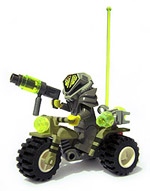
| An alien Assault Triker prepares for raiding. |
Assault Trike: 9 CP
(Horse: 9 CP, Steel: +0 CP) |
| Elements shown:
LEGO |
|
A Steel Horse (Cost: +0CP) is any Horse-sized machine or animated construction that lacks a mind of its own and carries one or fewer passengers. A Steel Horse has no Mind or Skill rating, and apart from its master's commands, is incapable of taking any Actions whatsoever.
Due to their mechanical construction, Steel Horses have an augmented Armor rating of 1d10, which grants them a much greater ability to do Damage in a Crash than their squishy biological equivalents (H.3: Fighting From Horseback). This comes in handy, since most mechanical Steel Horses lack the appendages that would allow them to make Close Combat Attacks.
When abandoned by its rider, a Steel Horse mostly just sits there, unless it was in motion at the time of the rider's departure. In this case, the Steel Horse continues moving forward at half speed for one round before coasting to a stop. (Common sense may dictate otherwise in some cases - abandoned airplanes in flight also come to a stop, but the process by which this occurs is referred to as "crashing" rather than "coasting.")
Examples: Motorcycles, golems, mini-tanks, mini-planes, tricycles, jeeps |
|
 |
 |
 |

| Only the undead Sea Zombies would think that Winged Swordfishes are a good idea for a combat vehicle. |
Winged Swordfish : 14 CP
(Horse: 9 CP, Flying: +5 CP) |
| Elements shown:
LEGO, Mega Bloks |
|
A Flying Horse (Cost: +5CP, or +10CP for a Flying Steel Horse) is any Horse with the ability to fly. This is indicated by placing stacks of blocks underneath them to raise them to the proper altitude. Transparent elements work best for this, since the support column doesn't represent anything in-game other than possibly the Flying Horse's shadow, but any elements can be used. A Flying Horse uses its Move inches to travel vertically, horizontally, or any angle in between, the same way that a regular Minifig moves along the ground.
Theoretically, Flying Horses can fly high enough to be out of vertical range of enemy ranged weapons, making them immune to attack as they rain down damage on their targets. This is extremely poor sportsmanship, and players should be ashamed of themselves for even considering it. Players should avoid flying at altitudes higher than five inches except to reach a high roosting point (the top of a tower or mountain, for example), except when their opponents also have Flying Horses to chase them.
Flying Horses cannot wear Horse Body Armor, due to the added weight. A Flying Steel Horse retains the Steel Horse's Armor rating of 1d10, but costs +10CP rather than +5.
Examples: Pegasi, speeder bikes, mini-copters, giant eagles, hang gliders |
|
 |
 |
 |
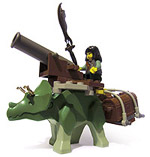
| Gun-Ceratops serves as dino-based artillery. |
Gun-Ceratops: 12 CP
(Horse: 9 CP, Gun: +3 CP) |
| Elements shown:
LEGO, custom |
|
A Gun Horse (Cost: +3CP) is any Horse with built-in ranged weapons. Whether from eye lasers, fiery breath, or machine guns, all Gun Horse Guns have the same weapon stats.
| Weapon |
Cost |
Use |
Range |
Damage |
Notes |
| Gun Horse Weapon |
| Gun |
3CP |
3 |
6" |
1d6 |
- |
|
Putting a Gun on a Horse doesn't replace any Close Combat abilities it may or may not have, but remember that Horses, like minifigs, can only make one type of attack per turn.
Examples: Fire dragons, cannon carts, ice dragons, snub spacefighters, lightning dragons, rainbow ponies, laser dragons |
|
 |
 |
| "Riding a horse is not a
gentle hobby, to be picked up and laid down like
a game of Solitaire. It is a grand passion." |
| - Ralph Waldo Emerson |
|
|
 |
Action Cost
Horses and other vehicles are more like equipment items than independent units; they need a minifig in control in order to be utilized properly. This control isn't free. For the average minifig, controlling a Horse costs him his Action for the turn.
| Riding Action Options |
| Horse Movement |
Directing the Horse to change speed and/or direction |
| Horse Action |
Directing the Horse to make either a Close Combat or ranged attack, or to use a mounted device or special ability |
| Minifig Action |
Any regular minifig Action from the rider, such as using a weapon or equipment item in hand, rather than directing the Horse |
|
 |
 |
Horse Movement
Because Horses lack independent initiative, the default movement for any Horse is to continue doing exactly what it was already doing on the previous turn. Unless a minifig spends his Action to direct the Horse's movement, the Horse will move in whatever direction it is facing, at the same speed it was traveling on its previous turn. If the undirected Horse runs into an obstacle, it will leap or climb over it if possible (to a maximum height equal to the Horse's legs or wheels); otherwise it will be stopped and possibly crash (H.3: Fighting From Horseback).
If a minifig is in a position to direct a Horse's movement, and uses his Action to do so, then the Horse moves as quickly and nimbly as its propulsion type would reasonably allow. A motorcycle-type Horse, for instance, isn't able to jump sideways the way a horse-type Horse can, or to cross rivers with the same ease as a speedboat-type Horse.
If a Horse is running in a straight line, it can be directed to Sprint like a minifig (4.1: Movement ), adding 1d6" to its Move for the turn. |
|
 |
 |
 |
Horse Action
A minifig might also use his Action to direct a Horse to take an Action of its own. In most cases this will be an attack, especially for Gun Horses, but might also be used in cases where a Horse has a special device or ability the minifig would like to make use of. A Horse may take an Angry Inch as part of a Close Combat Attack, if it's a type of Horse that's capable of being Angry.
When making Horse Actions, whenever a Skill Roll is called for, the lower of the Skill ratings of either the minifig or the Horse is used. (In the case of a Steel Horse, only the minifig's Skill applies.) |
|
 |
 |
 |
Minifig Action
Instead of directing the Horse, a minifig may make any of the usual types of Actions available to him, usually to attack with a hand weapon. Without any further direction, the Horse is left to continue running along in blissful ignorance. |
|
 |
The Rider
Every minifig has the basic level of skill required to operate a Horse, but few have the training and experience to excel at it. The Rider is an experienced horseman who moves as naturally on horseback as on his own two feet - and in some cases, even more so.
The Rider's advantage is simple: where lesser minifigs must pay an Action cost to direct a Horse's movement, the Rider does it automatically. This leaves his Action free for attacks using his own or his Horse's weapons, and improves his ability to move in and out of combat freely. The two are so closely bonded that the Horse can even take an Angry Inch as part of the Rider's Close Combat Attack, not just its own.
Directing a Horse to Sprint still costs the Rider an Action, although he can combine this Action with a Charge as usual.
| H.3: Fighting From Horseback |
|
For the most common types of combat, making attacks from atop a Horse is the same as making attacks on foot. While regular minifigs have to make the choice between spending their Action on making an Attack or steering the Horse, this doesn't affect the Attack process in most cases - they check their weapon ranges and make their Attack and Damage Rolls, exactly as usual. The areas in which a Horse's decreased mobility and increased size can make a difference, respectively, are in Close Combat and during a Charge.
Getting Carried Away
The question of whether or not Horses (or minifigs) have independent brains, or in fact any brains to speak of, is outside the scope of this chapter. What's clear is that it's not always as easy for minifigs to coordinate Movement and Action while on Horseback as it is while on foot. In many cases where Close Combat would normally force a minifig to stop and fight, and even sometimes when he would prefer to, his Horse will keep on running away with him even as he's in the midst of trading blows.
Normally, if a minifig in Close Combat attempts to Withdraw (5.2: Close Combat), he must use his Action to do so, and his opponent gets one free Counter against him when he lets his guard down to flee. However, if a minifig is carried out of Close Combat by a Horse or by other means, voluntarily or otherwise, he can get away without having to go through the usual Withdrawal pains. This is called Getting Carried Away. As long as a minifig spends his Action on Close Combat in a turn, his guard is never let down, and his opponent gets no free Counter when he's Carried Away. If the minifig has to use his Action to direct the Horse to leave, then it's treated as a normal Withdrawal and he is subject to a Counter as usual.
For normal minifigs, this means that Close Combat from Horseback is a difficult affair, since they can't steer a Horse and make Attacks in the same turn. They find themselves either losing attack opportunities from maneuvering their Horses into combat position, or taking individual swings as the Horse runs straight past a target because they don't have the Action remaining to tell the Horse to stop. For a trained Rider, on the other hand, mounted Close Combat is ideal. Because steering doesn't cost him any Actions, he can have himself Carried Away at the drop of a hat. This allows Riders to duck in and out of Close Combat as often as they please, while the poor foot soldiers remain hopelessly mired in whatever random melee happens to befall them.
Crashing and Trampling
Despite the efforts of Hollywood, a tragic number of adults have forgotten a fact that's obvious to every first-grader: vehicles are nice for carrying folks around, but their true purpose is crashing, and the faster you crash them, the better. This makes the most sense with mechanical vehicles like jeeps, airplanes, and star destroyers, but hand those young prodigies a toy horse or dinosaur and you'll see exactly the same thing happen.
Like a minifig, a Horse that Charges in a straight line for two inches builds up +1d6 worth of Momentum (MOM) (5.4: Charge!). However, because the Horse is twice as large, with a little more wind-up it can potentially build up twice as much power. If an un-Wounded Horse extends its Charge to four inches, its MOM bonus increases to +2d6. (A Wounded Horse is limited to MOM:1d6 no matter how far it Charges.) As usual, these bonus MOM dice can be added to the Damage from an attack with a Charging Weapon or to the inches of distance in a Shove, and they are used in the Horse's roll for KnockBack.
Crashing
Minifigs who run around crashing into things have a pretty minimal effect, except where plate glass windows or porcelain antiques are involved. Even in plate armor, their bodies are too small and soft to make effective projectiles without loading them into a cannon or catapult first (7.3: Weapons). The same is true for most Horses, whose soft fleshy bodies make them inappropriate for use as a ramming weapon.
Steel Horses, on the other hand, are perfect for the job. As long as a Steel Horse has built up at least two inches' worth of Momentum, it delivers 1d6 Crash Damage whenever it smashes into a target. Crash Damage is cumulative with any other Damage dealt out as part of the Charge, and can only be Parried with a Shield. Crashing requires no Skill Roll; a unit trying to collide with a target always succeeds unless the target successfully Bails out of the way.
Crashing into a Steel Horse hurts other units just as much; a Charging unit takes 1d6 Damage exactly as if the Steel Horse had Charged it itself. In the case of one Steel Horse crashing into another, they each do 1d6 Damage to the other.
Trampling
Minifigs are smaller than Horses, and therefore it's natural for Horses to want to stomp on them. Trampling is a means for a Horse to add insult to injury. If a minifig is lying on the ground Disrupted (4.3: Enemy Response), hopefully as a result of being Knocked Back by a Charging Horse, the Horse can Run Over the prone minifig for one additional point of Damage. Obviously a single point of Damage isn't enough to kill any regular minifig, but, cumulative with other injuries the minifig may have sustained during the Charge, that final additional point can sometimes make the needed difference.
Any number of Horses can Trample a Disrupted minifig in a single turn, but each does its point of Damage only once. Running the same Horse back and forth over a minifig a dozen times is funny but has no extra effect.
Horses do no damage to other Horses with Trampling, because they're the same size. Regardless, it's still funny to watch them run over each other.
KnockBack
While their higher potential Momentum increases Horses' ability to send opponents flying, their extra stability also makes them more resistant to KnockBack inches when they get Knocked Back themselves.
All Horses start with POP:2d6; this is reduced to POP:1d6 if they're Wounded. As for minifigs, a Charging attacker's Momentum roll must exceed this Physical Opposition in order for the Horse to be successfully Knocked Back. The Horse takes one point of Smash Damage for each inch of KnockBack prevented by immovable obstacles or objects its own size or larger. Smaller objects simply get Knocked Back along with the Horse.
Even if a Horse is successfully Knocked Back, it only becomes Disrupted if the KnockBack length from that direction is longer than the width of the Horse. Because most Horses are longer than they are wide, it's easier to knock them over from the side (where they may be less than an inch wide from right to left) than from the front or the back (along which axis they're likely to be two inches in length or more). A Horse that's Knocked Back any distance less than or equal to this length less simply lands on its feet and is ready to keep fighting as usual. A Horse that's Knocked Back further than this length lands on its side and Disrupted. A Horse Knocked Back twice this length lands upside-down and Disrupted, possibly allowing upside-down Trample Damage to its own passengers.
If a Horse and a target are Charging each other at the same time, the Horse makes a single KnockBack roll for both its MOM and POP if they're at the same level (MOM:2d6 / POP:2d6 for a fresh Horse, or MOM:1d6 / POP:1d6 for a Wounded one). In the occasional instance where a fresh Horse is only able to Charge two inches before the point of impact, it will only have built up MOM:1d6 compared to its POP:2d6. When this occurs, roll 2d6 for the Horse's POP and use the higher of the two dice for the Horse's MOM.
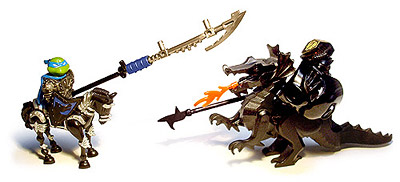
| A Jousting unit with a shorter lance may feel the need to compensate with a more impressive ride. |
| Elements
shown: Mega Bloks, LEGO, Little Armory |
|
Jousting
Jousting is the most characteristic attack of the mounted horseman, and it combines the fun of a mounted Close Combat attack with the calamity of a Crash. In a Jousting attack, a minifig with a Charging Weapon (normally a spear or lance, although any Charging Weapon will do (5.4: Charge!)) uses the power of his Horse's Charge to do heavy damage to a target - often another minifig on Horseback, and often one who's Jousting right back at him.
Lances
While any Charging Weapon can be used for Jousting, a long lance is the preferred tool, because lining up a Joust attack can be tricky if the point of the weapon doesn't extend past the nose of the Horse. For a minifig on foot, a Two-Handed polearm like a lance normally requires two hands and costs an inch of Movement, but the power of a Charging Horse allows a Jousting minifig to tuck a lance or other similar Charging Weapon under a single arm at no penalty. A Jousting minifig can even use its off hand to hold a Shield, which will come in handy if he's getting Jousted in return.
| Weapon |
Cost |
Use |
Range |
Damage |
Notes |
| Close Combat Weapons |
| Two-Handed Weapon (on foot) |
4CP |
4 |
CC |
2d6 (+MOM) |
Two-Handed; -1" to Move |
| Two-Handed Weapon (Jousting) |
4CP |
4 |
CC |
2d6 (+MOM) |
may be paired with Shield |
|
As with foot-based Charge attacks, the length of two Jousting minifigs' weapons can determine whether one side strikes first or if both sides' attacks strike simultaneously. If the minifig on either side has a weapon long enough to deliver an Attack at least one inch before his opponent is able to deliver a return blow, then he strikes first, regardless of whose turn it is or who initiated the Joust.

| Only the
most villainous of jousters aims to lance his opponent's
horse instead of the rider. |
| Elements shown:
LEGO, Little Armory |
|
Making the Joust Attack
Making a Joust attack is, for the most part, identical to attacking with a Charging Weapon on foot (5.4: Charge!); the Jousting minifig and his target have the same options and make the same rolls.
If the Close Combat Attack and possible Counterattack both miss, then the Jousting minifig will still be Charging ahead at full speed, and may end up Crashing his Horse into the target instead. Only the trajectory of the Charging Horse determines whether a collision will occur; not even a trained Rider is fast enough to change course to avoid (or cause) a Crash between the missed Joust and the moment of impact.
Unseating a Rider
As with all Charge attacks, KnockBack is determined by the MOM of the attacker and the POP of the target, whether the collision is due to a successful strike with a Charging Weapon or simply to the Horse crashing into its target. When the target of the Charge attack is the rider rather than the Horse, there's a chance for KnockBack to separate the two.
When determining the Physical Opposition of a mounted minifig, it's important to consider whether or not he's Strapped In, either with a saddle or seatbelts or some equivalent restraint. A minifig riding a horse-type Horse is Strapped In if there's a saddle involved; otherwise he's riding bareback. Minifigs sitting in the designated seating area of a vehicle-type Horse are automatically considered to be Strapped In with seatbelts or restraints; minifigs milling around in the bed of a pickup truck are not. Motorcycle riders and bicyclists are never Strapped In.
When a minifig is Strapped in, his Physical Opposition is determined by the Horse he's riding on (POP:2d6, or POP:1d6 if the Horse is Wounded). If he is successfully Knocked Back, he remains mounted while he and his Horse are Knocked Back together, away from the impact.
An un-Strapped minifig is limited to his own Physical Opposition (POP:1d6), gaining no advantage from his Horse. If he is Knocked Back, the KnockBack is applied directly to the minifig instead of to his Horse, Unseating him - the Horse will keep traveling in one direction (to the limit of its Movement) while the minifig suddenly finds himself flying in the other. Unseated minifigs are automatically Disrupted.
Even if the two rolls are a tie, the minifig can still be Unseated if his Horse is in motion - the Horse will run out from underneath him while the minifig stays in the same place. Even worse, if an un-Strapped minifig Jousts a target and fails to Knock it Back in the process, the exact same thing will happen - his Charging Weapon will jam into the unmoving target and his Horse will run out from underneath him.
 |
| Joust Example: Solo Jones vs. the Black Rider |

The Black Rider
Rider: 4CP Sk:1d6 Mv:4" Ar:1d6-1 Piloting
Body Armor: 1CP Ar:+2 Mv:-1"
Shield: 1CP Use:2 Dmg:1d6 (parry)
2H Weap: 4CP Use:4 Dmg:2d6
Steel Horse: 9CP Mv:10" Ar:1d10 |
| Elements
shown: LEGO, Mega Bloks, Little Armory |
|
|
Example: Thanks to a series of convenient plot twists, post-apocalyptic archaeology smuggler Solo Jones has managed to abscond with a Jaw-Jaw coven's sacred Poo-On-A-Stik.
As he makes his escape on his obligatory post-apocalyptic motorcycle, he finds himself confronted by the Black Rider, a mysterious highwayman who kills for pleasure and has never lost a joust.
The Black Rider is a well armed and armored Rider, with a Shield, Body Armor, and Lance in addition to his Steel Horse motorcycle (total cost: 19CP).
Solo Jones is a standard Minifig, with only his Steel Horse motorcycle, his hat, and the deadly Poo-On-A-Stik (total cost: 17CP).
|

Solo Jones
Minifig: 4CP Sk:1d6 Mv:5" Ar:1d6
2H Weap: 4CP Use:4 Dmg:2d6
Steel Horse: 9CP Mv:10" Ar:1d10 |
| Elements
shown: LEGO |
|
|
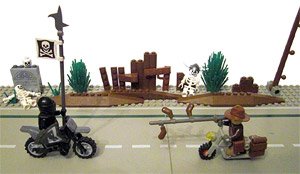
Jones Sprints and Charges, but fails to reach his target.
The Black Rider laughs at him. |
|
Jones' Turn :
Solo Jones guns the engine, Sprinting and Charging his motorcycle at his opponent. Sadly, he rolls a 1 on his Sprint die, and falls short on his Joust attack by a full three inches. The Black Rider laughs at him.
Turn Summary (Jones' Turn):
Jones declares Sprint and Charge.
Jones' Sprint Roll: 1, for total Move of 11".
Jones moves 11", successfully building 2d6 MOM, but failing to reach his target.
Black Rider laughs. |
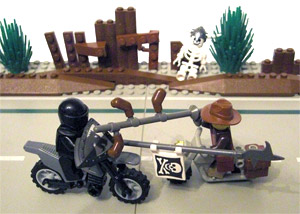
| The Black Rider meets the Charge in a monumental clash of steel and Poo. |
|
Black Rider's Turn (Combat):
The Black Rider backs up an inch to give himself room to build up a full 2d6 worth of Momentum. Peeling out, he lowers his lance and accelerates to meet Jones' Charge.
The Black Rider's lance has an extra inch of reach over the Poo-On-A-Stik, so the Black Rider strikes first in the Joust rather than both sides striking simultaneously. Attack Modifiers for fast movement are cancelled because the riders are Charging directly at one another; the Black Rider must make an unmodified Attack Roll against his lance's Use of 4. He rolls a 3 on his Skill of 1d6, barely missing Jones.
Feeling lucky to have survived, Jones may now make his Counterattack with his shorter weapon. Again, there are no Attack Mods to consider; Jones must make his Attack Roll against the Stik's use of 4. He rolls a 4 on his Skill of 1d6: success!
The strike does the Stick's Damage Rating of 2d6 plus Jones' Momentum Bonus of an additional 2d6, for a whopping 4d6 points of Damage. Jones rolls a 3, a 5, a 1, and a 2, for 11 points total. Bad news for the Black Rider!
The Black Rider attempts to Parry
the Poo with his Shield; he has to equal or exceed Jones' Attack Roll of 4 to succeed. Luckily, he rolls a 5, successfully Parrying the blow (but becoming ensmeared with Poo in the process). He rolls another 1d6 for the amount of Damage Parried by the Shield. This time he rolls a paltry 1, reducing the total Damage to 10.
As a Rider, the Black Rider's natural Armor is 1d6-1, plus 2 for his suit of Body Armor, bringing his total Armor to 1d6+1. Crossing his fingers, he rolls the Armor die - a 6! Happy to take advantage of his Critical Success, he rolls the Bonus 1d6 and scores an additional 3 points, for a total of 10 points of Armor (6+3+1) - exactly enough to survive Jones' powerful Poo attack. The Black Rider lives to laugh again!
Turn Summary (Black Rider's Turn: Combat):
Black Rider declares Charge; Momentum already at 2d6 thanks to Jones' Charge in progress.
Black Rider Attacks first. Attack Roll 3 vs. Lance Use 4: Miss.
Jones Counterattacks. Attack Roll 4 vs. Stick Use 4: Hit; Damage (3+5+1+2)=11.
Black Rider Parries. Attack Roll 5 vs. Jones' Attack of 4; Hit. Damage Parried 1, final Poo Damage (11-1)=10.
Black Rider is now slightly more brown.
Black Rider Armor Roll (6+3+1)=10
vs. Damage 10. Black Rider survives. |
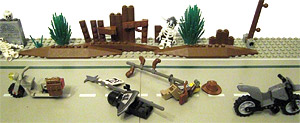
| The Black Rider and Jones fail to spike the dismount. |
|
Black Rider's Turn (Knockback):
With the Joust attacks resolved, it's now time to see which of the combatants will be knocked off their bike. Because the Black Rider missed his attack, he gets no KnockBack Roll against Solo Jones. If Jones can manage to Knock Back the Black Rider, on the other hand, he'll be able to run over him to deliver the final point of Trample Damage necessary to finish off the menacing character once and for all.
Both opponents have 2d6 Momentum, but motorcycle riders are always considered un-Strapped In, so the Black Rider only offers 1d6 of Physical Opposition. Jones rolls a three and a five for his Momentum, for a total of eight. The Black Rider rolls a six on his Physical Opposition die, earning another lucky Bonus Die; the Bonus Die comes up a two, for a total of eight - just enough to match Jones' KnockBack Roll.
Because the rolls are tied and neither rider is Strapped In, both halt in mid-air and are Unseated and Disrupted while their motorcycles fly out from underneath them.
Based on the angles the bikes are pointing, the players decide that they pass harmlessly alongside one another rather than smashing together in a Crash. The Black Rider's motorcycle continues forward to the limit of its Movement. As abandoned Steel Horses, each motorcycle will half its Move on its next turn before coasting to a stop.
Turn Summary (Black Rider's Turn: KnockBack):
Jones rolls MOM:(3+5)=8.
Black Rider rolls POP:(6+2)=8. The KnockBack Rolls are tied.
Black Rider and Jones are un-Strapped In; both are Unseated and Disrupted.
Black Rider's motorcycle continues forward its remaining 5".
Each motorcycle will coast 5" to a stop on its next turn. |
Joust Summary:
Both riders have survived, but are Unseated and Disrupted. Luckily for Jones, this happened on the Black Rider's turn, so Jones has the next turn and will recover first. It's hard to predict exactly what Jones will choose to do while the Black Rider is still unable to defend himself, but the Poo On A Stick has a way of giving a guy ideas. |
|
|
 |
|
|